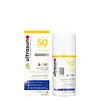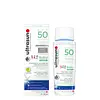What's inside
What's inside
 Key Ingredients
Key Ingredients

 Benefits
Benefits

 Concerns
Concerns

 Ingredients Side-by-side
Ingredients Side-by-side

Water
Skin ConditioningCaprylic/Capric Triglyceride
MaskingPentylene Glycol
Skin ConditioningMethylene Bis-Benzotriazolyl Tetramethylbutylphenol
UV FilterTitanium Dioxide
Cosmetic ColorantEthylhexyl Salicylate
UV AbsorberBis-Ethylhexyloxyphenol Methoxyphenyl Triazine
Skin ConditioningC12-15 Alkyl Benzoate
AntimicrobialDiethylamino Hydroxybenzoyl Hexyl Benzoate
UV FilterEthylhexyl Triazone
UV AbsorberGlycerin
HumectantSqualane
EmollientCocoglycerides
EmollientHydrogenated Phosphatidylcholine
EmulsifyingC8-22 Alkyl Acrylates/Methacrylic Acid Crosspolymer
Acrylates Copolymer
Decyl Glucoside
CleansingSilica
AbrasiveHelianthus Annuus Seed Oil
EmollientVitis Vinifera Seed Extract
AntimicrobialPropyl Alcohol
SolventCetyl Phosphate
EmulsifyingAlcohol
AntimicrobialSodium Hydroxide
BufferingXanthan Gum
EmulsifyingPropylene Glycol
HumectantEthyl Ferulate
AntioxidantPolyglyceryl-5 Trioleate
EmollientRosmarinus Officinalis Leaf Extract
AntimicrobialLecithin
EmollientTocopherol
AntioxidantTocopheryl Acetate
AntioxidantAscorbyl Tetraisopalmitate
AntioxidantDisodium Uridine Phosphate
Skin ConditioningDiisopropyl Adipate
EmollientUbiquinone
AntioxidantCitric Acid
BufferingWater, Caprylic/Capric Triglyceride, Pentylene Glycol, Methylene Bis-Benzotriazolyl Tetramethylbutylphenol, Titanium Dioxide, Ethylhexyl Salicylate, Bis-Ethylhexyloxyphenol Methoxyphenyl Triazine, C12-15 Alkyl Benzoate, Diethylamino Hydroxybenzoyl Hexyl Benzoate, Ethylhexyl Triazone, Glycerin, Squalane, Cocoglycerides, Hydrogenated Phosphatidylcholine, C8-22 Alkyl Acrylates/Methacrylic Acid Crosspolymer, Acrylates Copolymer, Decyl Glucoside, Silica, Helianthus Annuus Seed Oil, Vitis Vinifera Seed Extract, Propyl Alcohol, Cetyl Phosphate, Alcohol, Sodium Hydroxide, Xanthan Gum, Propylene Glycol, Ethyl Ferulate, Polyglyceryl-5 Trioleate, Rosmarinus Officinalis Leaf Extract, Lecithin, Tocopherol, Tocopheryl Acetate, Ascorbyl Tetraisopalmitate, Disodium Uridine Phosphate, Diisopropyl Adipate, Ubiquinone, Citric Acid
Water
Skin ConditioningZinc Oxide
Cosmetic ColorantDicaprylyl Ether
EmollientCoconut Alkanes
EmollientAlcohol
AntimicrobialPolyglyceryl-4 Diisostearate/Polyhydroxystearate/Sebacate
EmulsifyingHydrogenated Canola Oil
Skin ConditioningCocos Nucifera Oil
MaskingTitanium Dioxide
Cosmetic ColorantSilica
AbrasivePolyglyceryl-2 Dipolyhydroxystearate
Skin ConditioningPolyhydroxystearic Acid
EmulsifyingMagnesium Sulfate
Coco-Caprylate/Caprate
EmollientHectorite
AbsorbentUndecane
EmollientZinc Stearate
Cosmetic ColorantTridecane
PerfumingCetyl Phosphate
EmulsifyingMaltodextrin
AbsorbentCaesalpinia Spinosa Fruit Pod Extract
Tocopherol
AntioxidantHelianthus Annuus Sprout Extract
Skin ConditioningCitric Acid
BufferingHelianthus Annuus Seed Oil
EmollientWater, Zinc Oxide, Dicaprylyl Ether, Coconut Alkanes, Alcohol, Polyglyceryl-4 Diisostearate/Polyhydroxystearate/Sebacate, Hydrogenated Canola Oil, Cocos Nucifera Oil, Titanium Dioxide, Silica, Polyglyceryl-2 Dipolyhydroxystearate, Polyhydroxystearic Acid, Magnesium Sulfate, Coco-Caprylate/Caprate, Hectorite, Undecane, Zinc Stearate, Tridecane, Cetyl Phosphate, Maltodextrin, Caesalpinia Spinosa Fruit Pod Extract, Tocopherol, Helianthus Annuus Sprout Extract, Citric Acid, Helianthus Annuus Seed Oil
Ingredients Explained
These ingredients are found in both products.
Ingredients higher up in an ingredient list are typically present in a larger amount.
Alcohol comes in many different forms. Different types of alcohol will have different effects on skin. This ingredient is usually an astringent alcohol.
These alcohols are drying on the skin. They may strip away your skin's natural oils and even damage your skin barrier. Astringent alcohols may also irritate skin.
Other types of astringent alcohols include:
According to the National Rosacea Society based in the US, you should be mindful of products with these alcohols in the top half of ingredients.
Any type of sanitizing product will have high amounts of alcohol to help kill bacteria and viruses.
Fatty alcohols come from plant oils such as coconut oil. These can help hydrate the skin and are non-irritating. Some fatty alcohols include cetyl and stearyl alcohol.
Learn more about AlcoholWe don't have a description for Cetyl Phosphate yet.
Citric Acid is an alpha hydroxy acid (AHA) naturally found in citrus fruits like oranges, lemons, and limes.
Like other AHAs, citric acid can exfoliate skin by breaking down the bonds that hold dead skin cells together. This helps reveal smoother and brighter skin underneath.
However, this exfoliating effect only happens at high concentrations (20%) which can be hard to find in cosmetic products.
Due to this, citric acid is usually included in small amounts as a pH adjuster. This helps keep products slightly more acidic and compatible with skin's natural pH.
In skincare formulas, citric acid can:
While it can provide some skin benefits, research shows lactic acid and glycolic acid are generally more effective and less irritating exfoliants.
Most citric acid used in skincare today is made by fermenting sugars (usually from molasses). This synthetic version is identical to the natural citrus form but easier to stabilize and use in formulations.
Read more about some other popular AHA's here:
Learn more about Citric AcidHelianthus Annuus Seed Oil is the oil derived from the seeds of a Sunflower. Sunflower seed oil is non-fragrant. It is an emollient, meaning it helps to soften the skin.
Sunflower seed oil contains many fatty acids. The fatty acids found in sunflower seeds include (from highest amount to least): linoleic acid, myristic acid, palmitic acid, stearic acid, arachidic acid, oleic acid, and linolenic acid.
These fatty acids help the skin create ceramides. Ceramides play a role in repairing the skin barrier.
Helianthus Annuus Seed Oil helps moisturize the skin. This in turn helps the skin look more rejuvenated and smoother.
Sunflowers are rich in vitamin E.
Historians believe Indigenous cultures of North America domesticated sunflowers before corn. Thus they relied on sunflower oil for a variety of uses. One such use is moisturizing skin and hair.
Sunflower seed oil may not be fungal acne safe. We recommend speaking with a professional if you have any concerns.
Learn more about Helianthus Annuus Seed OilSilica, also known as silicon dioxide, is a naturally occurring mineral. It is used as a fine, spherical, and porous powder in cosmetics.
Though it has exfoliant properties, the function of silica varies depending on the product.
The unique structure of silica enhances the spreadability and adds smoothness, making it a great texture enhancer.
It is also used as an active carrier, emulsifier, and mattifier due to its ability to absorb excess oil.
In some products, tiny microneedles called spicules are made from silica or hydrolyzed sponge. When you rub them in, they lightly polish away dead skin layers and enhance the penetration of active ingredients.
Learn more about SilicaTitanium dioxide is a mineral UV filter widely used in sunscreens and cosmetics.
It is one of only two UV filters officially classified as “mineral” by regulatory agencies, the other being zinc oxide.
Titanium dioxide provides broad-spectrum protection mostly in the UVB and UVAII range, with some protection in the UVAI range.
While its UVA protection isn’t as strong as zinc oxide’s, the difference is minor.
A common myth is that mineral UV filters reflect UV light. However, modern research shows titanium dioxide absorbs UV radiation like chemical filters (~95% absorption & 5% reflection).
Thanks to its non-irritating nature, titanium dioxide is suitable for sensitive, acne-prone, or redness-prone skin. It is unlikely to cause "eye sting" like other sunscreen ingredients.
A major drawback of this ingredient is its white cast and thick texture. This is why mineral sunscreens often leave a white cast and are less cosmetically elegant than chemical/hybrid sunscreens.
To improve white cast and spreadability, micronized or nano-sized titanium dioxide is often used.
There are ongoing concerns surrounding nano-titanium oxide's impact on marine ecosystems.
There is no conclusive evidence that any form of titanium oxide (or any other sunscreen ingredients) will cause harm to marine ecosystems or coral reefs. The science is still developing but many consumers are keeping a close eye on this issue.
Please note, many destinations have reef-safety sunscreen rules. For instance, the U.S. Virgin Islands advises all visitors to use non-nano mineral sunscreens.
Nano mineral sunscreens once raised safety concerns about absorption into skin.
Extensive research has shown that they do not penetrate healthy or damaged skin; they remain safely on the surface and the top layer of dead skin (stratum corneum).
You'll likely find titanium dioxide bundled with alumina, silica, or dimethicone. These ingredients help make titanium dioxide highly photostable; this prevents it from interacting with other formula components under UV light.
Learn more about Titanium DioxideTocopherol (also known as Vitamin E) is a common antioxidant used to help protect the skin from free-radicals and strengthen the skin barrier. It's also fat soluble - this means our skin is great at absorbing it.
Vitamin E also helps keep your natural skin lipids healthy. Your lipid skin barrier naturally consists of lipids, ceramides, and fatty acids. Vitamin E offers extra protection for your skin’s lipid barrier, keeping your skin healthy and nourished.
Another benefit is a bit of UV protection. Vitamin E helps reduce the damage caused by UVB rays. (It should not replace your sunscreen). Combining it with Vitamin C can decrease sunburned cells and hyperpigmentation after UV exposure.
You might have noticed Vitamin E + C often paired together. This is because it is great at stabilizing Vitamin C. Using the two together helps increase the effectiveness of both ingredients.
There are often claims that Vitamin E can reduce/prevent scarring, but these claims haven't been confirmed by scientific research.
Learn more about TocopherolWater. It's the most common cosmetic ingredient of all. You'll usually see it at the top of ingredient lists, meaning that it makes up the largest part of the product.
So why is it so popular? Water most often acts as a solvent - this means that it helps dissolve other ingredients into the formulation.
You'll also recognize water as that liquid we all need to stay alive. If you see this, drink a glass of water. Stay hydrated!
Learn more about Water